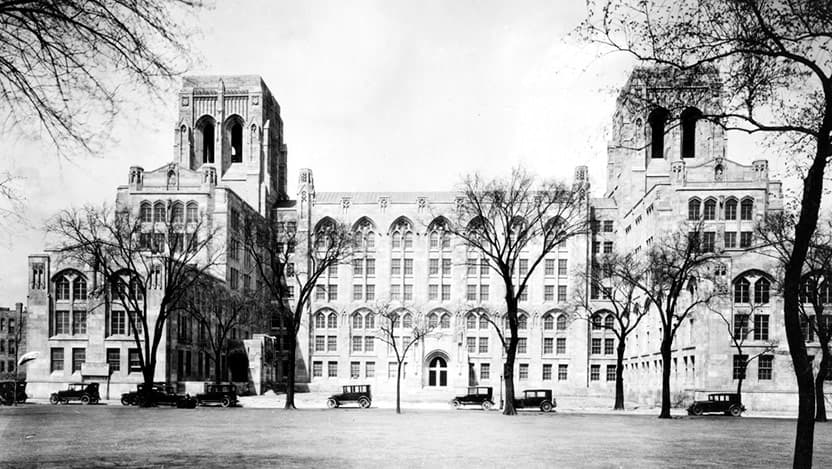UChicago Medicine celebrates 90 years of patient care

In the fall of 1927, a special two-day convocation marked the opening of the University of Chicago’s first medical school building, called Abbott Memorial Hall, and the 215-bed Albert Merritt Billings Hospital.
Ninety years later, the University of Chicago Medicine has grown to become one of the nation’s premier academic medical centers with more than 760,000 patient encounters a year and 9,000 employees. Along the way, we developed the concept of chemotherapy to fight cancer, discovered REM sleep and pioneered the field of organ transplantation. (Just to name a few.)
Before all that, though, the UChicago Medicine’s first patient would need care for sore and bleeding gums.
Shown in records as Victor S., the hospital’s first patient arrived Oct. 3 – nearly a month before the buildings were officially dedicated. The care team suspected Victor had a case of Vincent’s infection, known colloquially as “trench mouth.” A bacterial smear confirmed the diagnosis and Victor was treated with Salvarsan, an early antibiotic derived from arsenic and considered the first modern chemotherapeutic agent. A follow-up visit showed the treatment was successful. (Victor appeared to remain in good health before eventually returning to the hospital seven years later with typhoid.)
The newly minted hospital’s first surgical patient arrived the same day.
Marian L. P. suffered from a stiff left elbow, caused by a fall five years earlier. Two days later, Dallas B. Phemister, MD, the first chair of the school’s Department of Surgery, performed an operation to restore motion to the man’s arm.
The six-story Billings Hospital occupied two city blocks facing the Midway Plaisance park and cost $4.5 million to build – far higher than initially budgeted. Adjusting for inflation, that’s the equivalent of $60 million today.
In less than three years, the medical campus would start expanding.
The 80-bed Bobs Roberts Memorial Hospital for children opened in the spring of 1930, named for the deceased son of a major donor. One year later, the 140-bed obstetrical facility Chicago Lying-in Hospital opened on the corner of 59th Street and Maryland Avenue, moving from another location. Operated by the renowned obstetrician Joseph Bolivar DeLee, MD, the $2.4 million facility was deliberately separate from the other hospitals to reduce traffic and contamination, according to historical documents.
The burgeoning medical complex continued to grow, adding a special orthopedic facility for children, research buildings and scores of other spaces for patient care, research and medical education.
As the medical campus expanded – and along with it the number of patients – UChicago Medicine remained committed to melding research, teaching and medical care for members of the community.
In 1932, five years after the first hospital opened, a team led by Emmett Bay, MD, published a monograph on quality of care. The research team reviewed 447 randomly selected patient records and followed up by interviewing many of those patients and their doctors.
The group was initially troubled to find 34 percent of those patients never returned for follow-up visits. But, the researchers found, the lack of visits wasn’t due to patient dissatisfaction. Instead, many patients said they felt that a second visit simply was not necessary. Others chose not to return because they could not afford further treatment. (At the time, a semi-private room cost $6 to $7 a day.) Others admitted being confused about whether they were expected to return or felt they lacked guidance.
On the whole, however, Bay’s team was pleased. They concluded that leaders of Chicago’s medical profession “would be satisfied with the quality of the work.”
We hope patients and health care providers continue to say the same today

